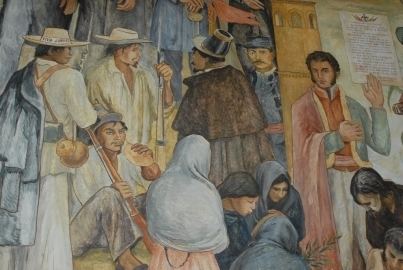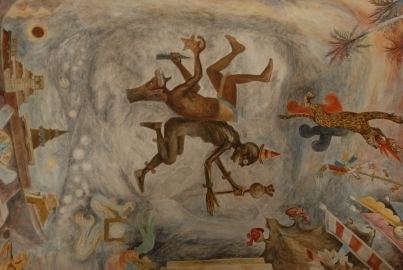Name Rina Lazo | ||
 | ||
Entrevista con rina lazo acerca del muralismo primera parte
Rina Lazo, full name Rina Lazo Wasem, (b. October 23, 1923) is a Guatemalan/Mexican painter, who began her career in mural painting with Diego Rivera as his assistant. She worked with him from 1947 until his death in 1957 on projects both in Mexico and Guatemala. Since then she has remained an active painter, better known for her mural works than canvases although the latter have been exhibited in Mexico and other countries making her one of Guatemala’s better known artists. She is a member of the Mexican muralism movement and while she criticizes modern artists as too commercial and not committed to social causes, she believes the muralism will revive in Mexico because of its history.
Contents
- Entrevista con rina lazo acerca del muralismo primera parte
- Rina lazo tierra fertil usac f4v
- Life
- Career
- Artistry
- References

Rina lazo tierra fertil usac f4v
Life

Rina Lazo was born on October 23, 1923 in Guatemala City to Arturo Lazo and Melanea Wasern. She attended primary through high school at the Colegio Alemán. She spent her childhood in Cobán, where she had contact with local Mayan peoples, which would later have impact on her art.

Lazo began her art studies at the Academia Nacional de Bellas Artes (today the Escuela Nacional de Bellas Artes) in the early 1940s. There she worked as an assistant to Julio Urruela painting murals at Guatemala’s National Palace. In 1945, she won a scholarship from then President Arévalo to study art in Mexico, at the Escuela Nacional de Pintura, Escultura y Grabado "La Esmeralda". She states this is why she left the country, not the revolution that was taking place at the time. At the school, she studied with Carlos Orozco Romero, Jesús Guerrero Galván, Alfredo Zalce, Federico Cantú and Manuel Rodríguez Lozano but quickly became a favorite student of Diego Rivera, who she calls her best teacher. She met Frida Kahlo at her and Rivera’s home in Coyoacán, where she was invited to eat. She did not like spicy food, but Rivera told her she needed to learn how to appreciate chile peppers to appreciate Mexico.

She has since continued live in Mexico although she maintains family ties in Guatemala.
Her early artistic, social and political life was strongly tied with that of Rivera and Kahlo, and she became a militant supporter of the Mexican Communist Party.
She also met her husband through her association with Rivera and Kahlo. Arturo García Bustos was one of “Los Fridos,” students of Frida Kahlo. They married in 1949 when Lazo was 25. The couple is still married and lives in the Coyoacán borough of Mexico City. Their house is a colonial structure called Casa Colorada, on Calle de Vallarta in the La Conchita neighborhood of Coyoacán. Their home is said to be a residence of La Malinche. It was later a monastery, prison and hospital. After living there for more than forty years, in 2006, they opened part of it on the ground floor to house the Galería de la Casa Colorado. This gallery is run by the couple’s only daughter, Rina García Lazo, who is an architect specializing in the restoration of monuments. Lazo says that the house and the surrounding neighborhood have inspired both of them for its history and the legends associated with it.
Career
Lazo’s art career began soon after she arrived to La Esmeralda, when Diego Rivera hired her as an assistant. Her first collaboration with him was in 1947, on the mural called Sueño de una tarde dominical en la Alameda Central for the Hotel del Prado. Rivera called her his “right hand” and “the best of his students.”
From then until his death in 1957, she worked with him on a number of murals, which led her career to be mostly in mural painting. These projects included murals done at the Cáracamo del Río Lerma in Chapultepec called El agua, origen de la vida sobre la tierra (1951), the natural stone mural at the Olympic Stadium at Ciudad Universitaria (1952), two at the Hospital La Raza, El pueblo en demanda de salud and Historia de la medicine en México (1953), and one in Guatemala, La gloriosa victoria (1954) at the Palacio Nacional de Cultura. The last one depicts the coup the ousted Guatemalan president Jacobo Árbenz, in which blame is cast at the United States. Lazo herself appears in this mural as a young guerilla fighter in a bright red blouse.
In addition to working with Rivera, Lazo has done a number of her own mural projects over her career. She has produced frescos, murals in vinyl and stucco in Guatemala City and various locations in Mexico. Before she married, she created a mural at the Escuela Rural de Temixco with the aim of getting the Communist Party recognized in the state of Morelos. Her next mural was Tierra fertile in 1954,based on scenes from the Tikal area at the Museo de la Universidad de San Carlos in Guatemala. Another done in Guatemala is Venceremos in 1959, for which later the Guatemalan government would honor along with other murals. In 1966, she created two reproductions of the pre-Columbian murals at Bonampak. The first and larger was done at the Museo Nacional de Antropología in Mexico City in a reproduced Mayan structure created for the work. She was selected for this job due to her experience in working in frescos with Rivera. This work led to the request for a second reproduction, this one on movable panels for a television company. In 1995, she created another mural for the Museo de Antropologia called Venerable abuelo maiz. Although she and her husband, García Bustos, were both students of Kahlo and Rivera, they had not worked together over their careers because of different interests. However, in 1997, she worked with her husband to design and paint a 2.7 by 7 meter portable mural called Realidad y sueno en el mundo maya. Mágico encuentro entre hombres y dioses, which was inaugurated at the Hotel Casa Turquesa in Cancún .
Her canvas work is less known but her first prize-winning piece is titled Por los caminos de la libertad created in 1944. Her work was displayed in Germany, Austria, France, the United States, Mexico, Guatemala, Korea and other countries. This has made her one of the better known Guatemalan artists internationally.
She worked as a teacher of the fine arts in several institutions such as the Escuela de Restauración of the Instituto Nacional de Bellas Arts, the Secretarial of Public Education and the Escuela de Bellas Artes in Oaxaca. She also gave classes at the Casa del Lago in Chapultepec. She has also given seminars and workshops on at the Museo Nacional de Antropología in Mexico City, the Galerías de la Ciudad de México, the Casa de Cultura in Oaxaca, as well in the cities of Guatemala, Leipzig and Pyong Yang.
Lazo has been recognized for both her work with Rivera as well as her own independent projects. She received the Emeretisimum prize from the Faculty of Humanities of Universidad de San Carlos de Guatemala.
In 2004, she received the Order of the Quetzal from the Guatemalan government for her life’s work. In 2005, she received the Medal of Peace her home country as well. In 2010 she received a recognition from Romania, and led the protocol of the “changing of the Rose of Peace” at the Palacio Nacional de la Cultura, which celebrates the signing of peace accords realized in 1996.
Abel Santiago wrote her biography, Sabiduría de Manos, published in 2007, which also includes texts from Andrés Henestrosa, Henrique González Casanova, María Luisa Mendoza, Otto-Raúl González and Carmen de la Fuente . She has had a number of homages in places such as the Museo Mural Diego Rivera. The Mexican embassy in Guatemala paid tribute to her with an exhibition of panels of her work depicting the murals of Bonampak at the Centro Cultural Luis Cardoza y Aragón in 2010. She and her husband were invited to the United States to recount their time with Rivera in 2011. Lazo has been also a member of Mexico’s Salón de la Plástica Mexicana honor society since 1964.
Artistry
As a disciple of Rivera and Kahlo, Lazo is part of the Mexican School of Painting or Mexican muralism movement. Working with the muralists, she learned that artists should not be isolated from society, but rather “be in the streets” and observe what is happening. One other influence is that of her favorite writer, Miguel Ángel Asturias, who she met as a child, and again in Mexico much later. Asturias has written about her work as well
She prefers fresco painting, but her canvas works are noted for their interpretative quality, such as "El espejo de mi studio" from 2001, which features herself in a mirror which is surrounded by children.
Lazo feels that art and artists today are too commercialized and no longer committed to social causes. Although mural painting does not enjoy the popularity today as it once did, Lazo still feels that Mexican muralism is important and relevant. She points out that major protagonists with the movement, such as Frida Kahlo and Diego Rivera, still have international name recognition and exhibits of their work. Lazo believes that it will make a comeback because of Mexico’s long history with this art form and its association for reflection social and political issues.
